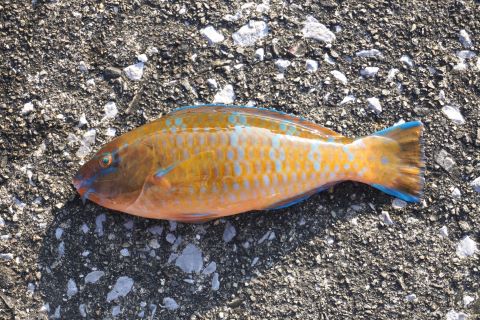
The appearance of Blue-barred parrotfish (Hibudai)
Common name: Blue-barred parrotfish, Yellowscale parrotfish, Yellow scale parrot fish, Cream parrotfish, Blue trim parrotfish, Globe-headed parrotfish, Green blotched parrotfish, Blue-barred orange parrotfish, Blue parrotfish, Dussumier’s parrot fish, Flame-breasted parrot-fish, Flame parrotfish
Japanese name: Hibudai (緋舞鯛)
Taiwan common name: 藍點鸚哥魚、鸚哥、黃衣魚、青衫 (雄)、紅蠔魚 (雌)、紅衫、蠔魚 (雌)(澎湖)
Chinese common name: 青点鹦嘴鱼
French common name: Kakatoi blanc
Spanish common name: Loro, Loro barba azul, Loro barbazul, Loro de escamas amarillas, Loro perico
Portuguese common name: Nyabugui senene, Papagaio, Papagaio de escamas amarelas
Scientific name: Scarus ghobban Forsskål, 1775
Nigiri sushi detail: Blue-barred parrotfish (Hibudai) Nigiri sushi
Characteristics:
Blue-barred parrotfish (Hibudai) are distributed south of Wakayama Prefecture and in the Indo-Pacific region. It inhabits shallow reefs and coral reefs. The body length is 40~60 cm. The maximum length reaches 80 cm. Females are yellowish brown with 5~6 blue transverse bands. Males are bluish overall. Females form small schools around their prey, while males are often found alone.
This fish is more for appreciation than for eating. The dark red meat (chiai) is not noticeable, and the skin has a delicious flavor, so it is recommended to eat it as Kawashimo-zukuri without removing the skin. Recently, it seems to be caught in Sagami Bay and is already being used for Nigiri sushi at conveyor-belt sushi restaurants. If it is caught in a little larger quantity, it may be offered at sushi restaurants in the Kanto region. Its flesh does not become hard even when cooked, and its rather light flavor makes it suitable for grilling with butter or meuniere.
Share this article